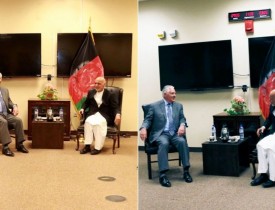AVA- close inspection by The New York Times found significant discrepancies in the photographs that may be explained by an effort to use image-manipulation software to doctor at least one of the images.
Both the photograph released by the U.S. and the one provided by Afghanistan depict Tillerson and Ghani seated at the front of a windowless room, flanked by their delegations.
However, the image released by Afghanistan does not include either the military-style digital clock or the large fire alarm that appear directly above Tillerson and Ghani in the photograph produced by the U.S. government, The Times reported. And in the Afghan photograph, the room is much more brightly lit.
According to an image expert cited by the Times, there is “no question” the Afghan photo was altered. The giveaway, the expert told The Times, is that whoever apparently doctored the Afghan image did not entirely remove the power cord that led to the clock and fire alarm in the U.S. photograph.
The question remains: Why would Afghanistan’s government manipulate a routine photograph of a visiting dignitary?
After Tillerson’s meeting with Ghani on Monday, the American Embassy and Ghani’s office released a statement claiming that the two men had met in Kabul. But the Times noted that the meeting actually occurred at Bagram, the U.S. military base more than thirty miles from Afghanistan’s capital.
Removing the military-style clock and large fire alarm might have been an attempt by Afghanistan’s government to conceal the meeting’s location. By claiming that Tillerson and Ghani were in Kabul and not a fortified military base, the Afghan government can project strength and advance a positive narrative about the country's security.
Neither Ghani nor Tillerson’s office has provided an explanation for the discrepancy in the images, or why the American Embassy signed off on the statement claiming the meeting was in Kabul.







